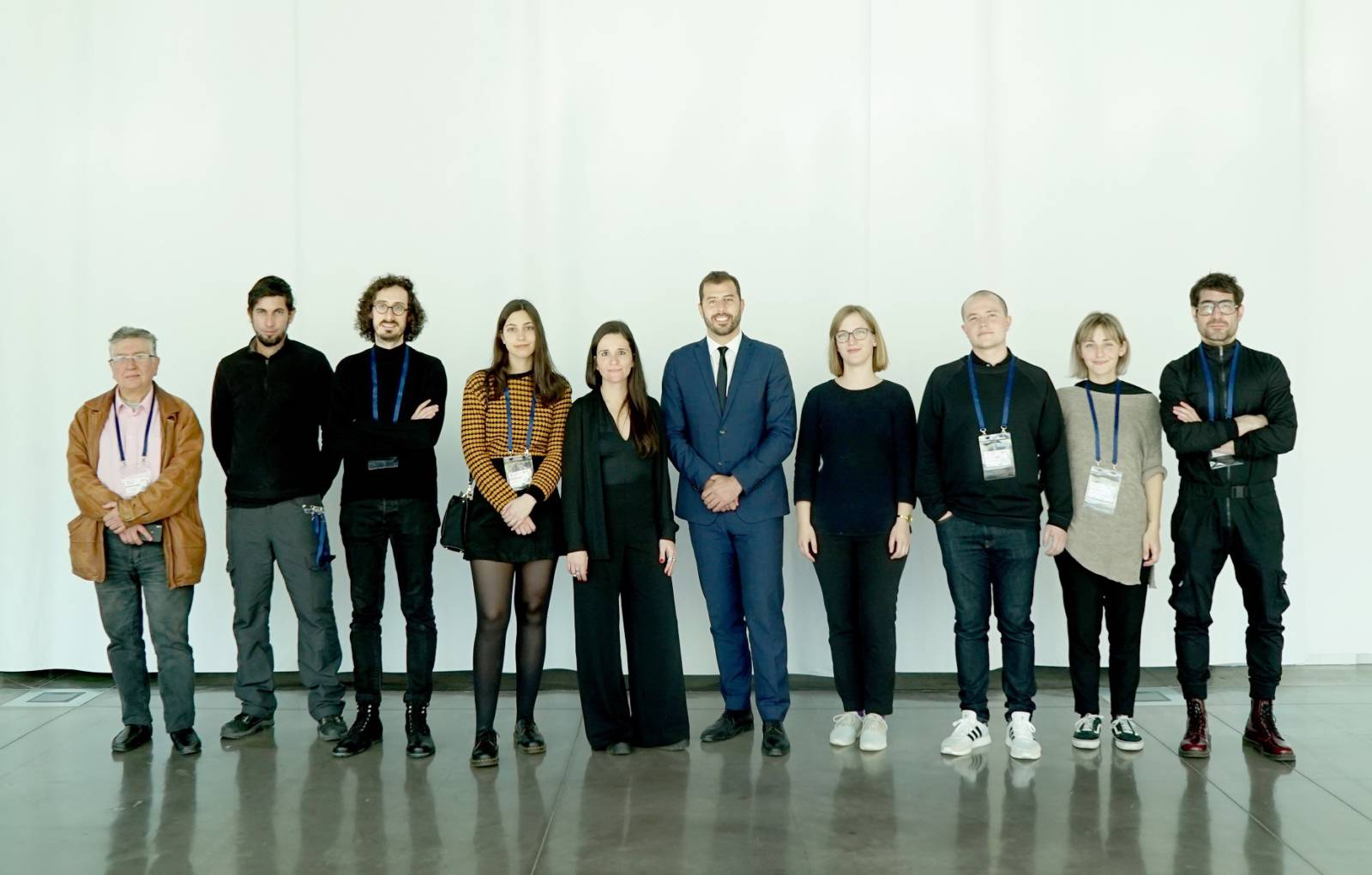
- The exhibition, which brings together 14 works that integrate technology and innovation in their creation, was inaugurated today and will remain open to the public at Disseny Hub Barcelona until 16 March
- At this new edition, the BEEP Electronic Art collection is taking part as a guest and contributing four works, notably among which is Tycho by Paul Friedlander
- During the inauguration, the artist Albert Barqué-Duran painted live a sculpture of a 3D emoji that was built using Artificial Intelligence

14 February, 2019
Barcelona, 14 February 2019.- Today, Mobile Week Barcelona 2019, a Mobile World Capital Barcelona (MWCapital) initiative, presented 14 works by digital artists in the collective exhibition entitled “Our simple relation with technology”. The exhibition prompts reflection on issues that include Artificial Intelligence, the power of bitcoins, the influence of the social networks on the media and the impact of robots on society.
The exhibition, which is being held as part of the 3rd Mobile Week Barcelona, brings together Art, Science and Technology and may be visited at Disseny Hub Barcelona from today, 14 February until 16 March. A specialised jury including Lívia Nolasco-Rózsás, from ZKM, and Rosa Ferré, Director of Matadero Madrid, selected 10 of the works to be displayed in the exhibition. The four remaining works on show are part of the BEEP Electronic Art collection, which this year features as a special guest.
The artists, who are free of creative or technical limitations, consider new approaches to technology, which enable visitors to view the direct impact that technology has both in their private and professional lives. This new Mobile Week Barcelona exhibition will give visitors the chance to experience futuristic fictitious scenarios showing how a smartphone chooses them and not the other way round, as we tend to think. Visitors can also fantasise about a robotised society in which robots themselves evolve as a group at such a high social and emotional level that they are able to assume human behaviours such as gossiping. This presents us with new paradigm: empathic robots that cooperate and recognise their colleagues in a group, just like we do.
Special guest 2019: BEEP Electronic Art Collection
The Mobile Week Barcelona 2019 exhibition will feature the BEEP Electronic Art Collection as a special guest. This collection seeks to bear witness to relations among Art, Science and Technology and on this occasion will exhibit four of its works, notable among which is Tycho: Test One by Paul Friedlander. Produced in collaboration with the Eurecat technology centre for research into communication and new technologies, the work consists of a luminous translucent concrete monolith with which the artist was the first person ever to work. Friedlander has a track record of over two decades investigating new technologies and procedures that involve making light malleable and flexible and able to acquire any shape and volume.
This creation will also be accompanied by Try Not To Think So Much, by Eugenio Ampudia, the latest work to be awarded the ARCOmadrid/BEEP Electronic Art Award, the animation Gust, by Daniel Canogarm, and the work Luci by José Manuel Berenguer.
The BEEP Electronic Art Collection is the result of the initiative of the TICNOVA Group which channels its enthusiasm for promoting technology-related artistic creation to encourage communication among technology developers/creators and artists. This natural collaboration benefits and enriches both worlds. Since its origins it has been associated with the ARCOMADRID Contemporary Art Fair and in twelve years has generated one of Europe’s major Electronic Art collections: 36 works that sum up the wealthy, diverse technological trends in artistic practice.
A 3D emoji painted live
ULTIMATE EMOJI, the work of the artist Albert Barqué-Duran was in the spotlight during the inauguration of the new edition of Mobile Week Barcelona. The artistic creation, which used Artificial Intelligence to generate an Emoji-shaped sculpture, was 3D-printed on a large scale, and the artist painted it on the first day of the exhibition.
In this creation Barqué-Duran combines two genres of contemporary art –performance and artistic installation– and seeks to prompt reflection on how today’s digital memes shape our cultural values and the way in which we show our emotions.
Detail of the artists and the creations selected to take part in the Mobile Week Barcelona 2019 exhibition
Miguel Soliman López Cortez | Inverse Triangulation
Inverse Triangulation encourages reflection on how technology keeps us permanently localised and allows for neither absences nor silences. It does so through an installation by placing on the floor in the centre of a room a three-dimensional clock that turns during a countdown. Every 4.33 minutes (in homage to the work composed by John Cage) a synthetic voice recites the coordinates of the geographical location of Miguel Soliman López, the work’s author. Although the artist is not physically part of the artistic composition, through the use of technology the body of Soliman López, in data format, is present in the room.
Martin Nadal & César Escudero | Bittercoin
BitterCoin is an old calculator that has been hacked so it may be used as a data extraction system that validates pending bitcoin transactions on Blockchain. In recent years, this system has triggered a competitive struggle in which computational power is the main variable for earning bitcoins. This involves the use of large systems, computer farms that consume physical and environmental resources. BitterCoin resumes this discourse rhetorically; it works as the most basic computer and increases the time necessary to produce bitcoins to virtually an eternity.
María Castellanos & Alberto Valverde | Environment Dress 2.0
Environment Dress 2.0 is a smart dress that measures the aggressiveness of the environment in order to analyse how this affects people’s state of mind and behaviour. This dress is equipped with sensors to analyse aspects such as variations in noise, temperature, atmospheric pressure, ultraviolet radiation and carbon monoxide levels to which we are subject in daily life. All this information generates a large database that is created with compiled geolocalised references. Winning project of Next Things 2015 – Behaviour, a joint award of LABoral Centro de Arte & Telefónica I+D.
Adriana Tamargo & Guillermo Escribano | MatchPhone
MatchPhone explores a lifelong relation with our smartphones. It has been suggested that Artificial Intelligence will have different personalities and will be personalised for each customer. The work therefore presents a near future in which a telephone is not chosen for its technical specifications but rather for its personality and its ability to adapt to needs. This is the background for creating a futuristic shopping experience whereby the decision to purchase a telephone is not only the user’s but also the result of a coincidence between both parts: once the telephone chooses you, you may or may not accept.
Karin Fischnaller | Karin and Karin Anders 0.2
This project explores the potential of human-bot collaborations. In a speculative scenario the human designer Karin teams up with her synthetic alter ego: the bot designer Karin Anders. Together Karin and Karin Anders investigate how technology will influence the design profession. Fischnaller’s new born digital colleague is not a design tool, but an equal partner that can complement her and vice versa: hear a collage of their thoughts and doubts taken from the podcast series “Karin and Karin Anders”.
Ivar Veermäe | The Flood
The Flood combines different presentation formats. It is both a documentary-format audio-visual projection that shows research into cryptocurrency, its mining and its energy needs, and also a series of simulated 3D objects that represent abstraction based on forms, concepts and ideas.
Mónica Rikić | Data gossiping robots: a speculation about future social relations between artificial entities
This project speculates about future social relations among artificial entities. It involves an interactive installation that represents a robotised micro-society in which communication is based on rumours about personal data from social network users’ profiles. It aims to present a future scenario of a hybrid social coexistence among artificial entities and human beings. It conceptually explores the possibility of robots evolving socially and emotionally as a group to the point where they start gossiping as a tool of empathy, cooperation and recognition of colleagues in the group, in the same way as we humans do.
Martina Solés Caldés | The End of Emotional Privacy
The End of Emotional Privacy is a bodysuit that reads and stores people’s emotions. The project applies infrared sensor technology to simulate thermal vision and ‘read’ emotions. By standing in front of it, the user’s emotions are read and mapped as heat into the back of the bodysuit. In this way the person wearing it can feel and identify other people’s emotions. In a context of growing concern over data privacy, where corporations know who we are and what we want, The End of Emotional Privacy suggests a future in which our emotional states are monitored, manipulated and monetized.
Fidel García | Post-society
The Post-society project involves the design of a new concept of mass media based on broadcasting the collective intelligence of social networks on an official radio channel (98.00MHz/range 5-10km) and updating the information control model established by power systems.
Albert Barqué- Duran | ULTIMATE EMOJI
How do digital memes and emojis shape our present cultural values and understanding of our emotions? ULTIMATE EMOJI is a work of art, science and technology that has arisen from the impact of digital transformation in our society. This is an emoji sculpture built using Artificial Intelligence. This same sculpture is then 3D-printed in a large-scale format and lastly painted in a traditional way by the artist.
Stay up to date about everything
Subscribe to stay up to date with the latest content from Mobile World Capital Barcelona.